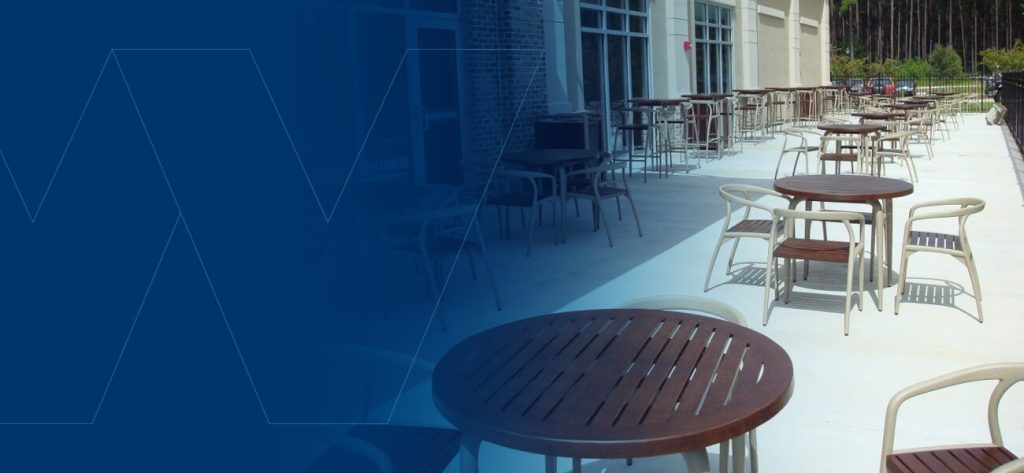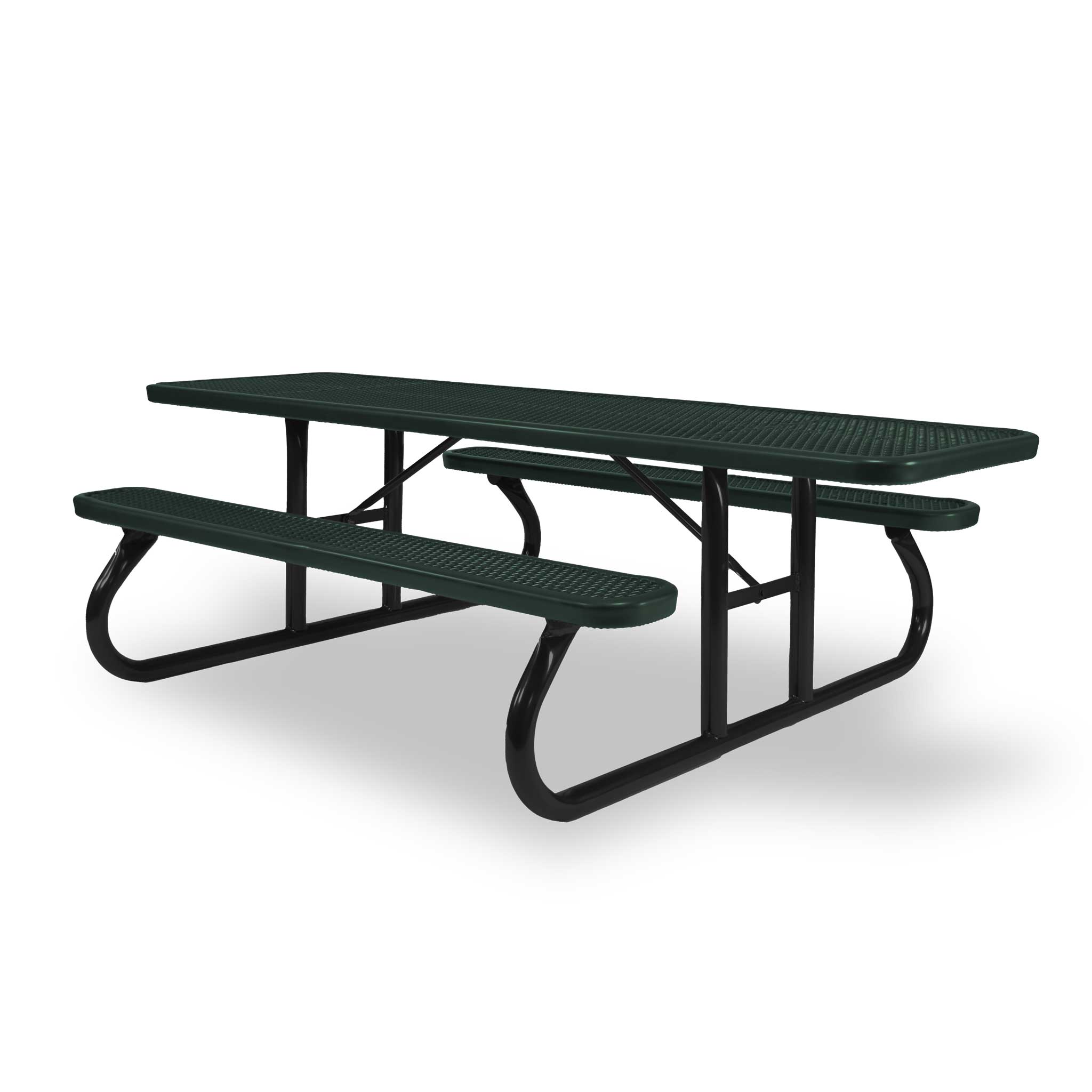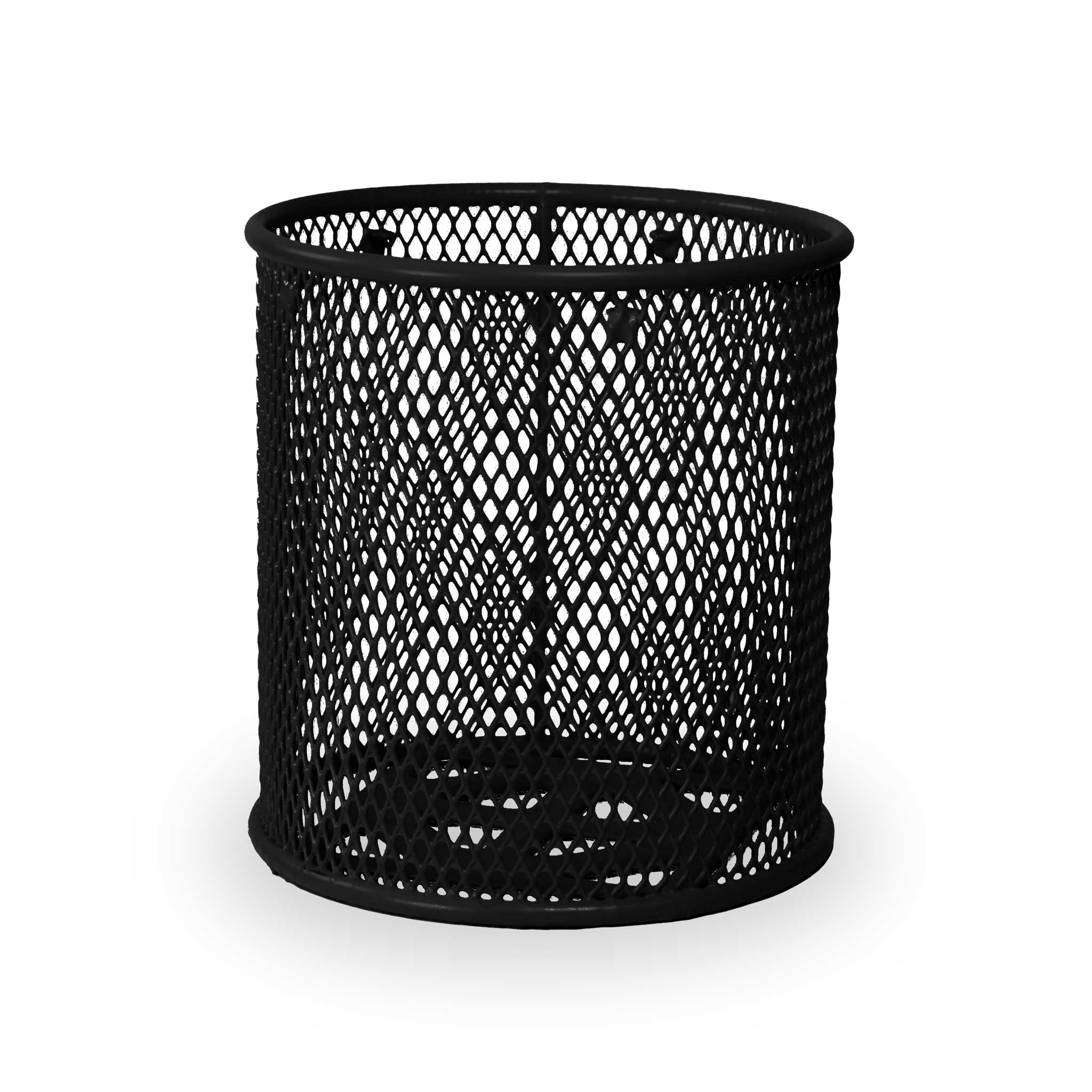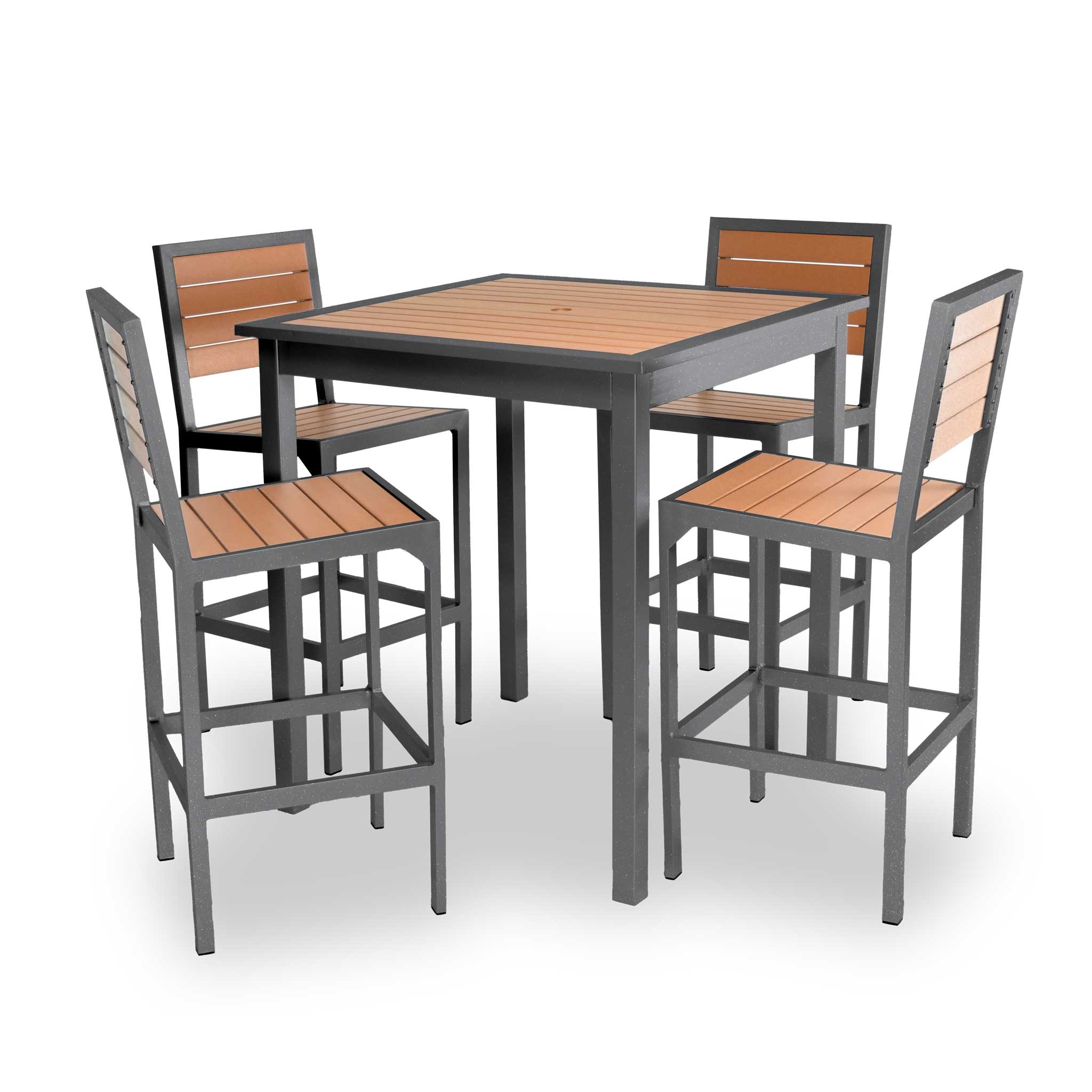Creating Outdoor Patio Space for Your Business

Uncategorized | Sep 25, 2023
Patios are an excellent way for businesses to expand their services and available space. Because designing outdoor areas comes with several unique considerations, having a comprehensive guide can ensure you include every essential element.
The Benefits of Outdoor Patio Space
Transforming your outdoor spaces into seating areas and patios can offer several benefits. Adding an outdoor patio space might support your company’s needs to accomplish a goal or expand your services. Some advantages of a business outdoor patio space include:
- Increasing property capacity: Adding more tables and seating options outdoors is a great way to accommodate more people. Whether you want to reach new audiences or cater to high demand, outdoor patio areas allow businesses to use available property space. This benefit is especially useful for restaurants — when you can seat customers quicker, they will have a better experience at your location, improving their relationship with your brand.
- Boosting revenue: Increased capacity means you can serve more customers at the same time. From restaurants to other businesses, more space and better services will encourage visitors to continue spending time and money at your location. Many companies design their outdoor areas to be extra comfortable, allowing guests to stay even longer, order more food and drinks or explore the goods and services you offer.
- Adding more experiences: Outdoor seating and dining spaces can expand the experiences offered at your business. Many companies have standard indoor spaces and bars. With outdoor areas, customers can choose how they spend their time at your business. When looking for a specific experience, customers might even seek out your location because they know you have what they want.
- Improving business competitiveness: If you want your business to stand out from the local competition, adding unique features like outdoor patios can help, especially if your competitors don’t have them. When other local companies have patios and outdoor seating, offering that option at your location can help maintain customer expectations. You can also add unique design elements and features to help distinguish your patio from others.
- Catering to parents and pet owners: Various audiences have different needs, so a patio can support your goals when trying to reach new ones. Parents with young kids often struggle to find locations they can go to because kids can be loud and energetic. Outdoor spaces like patios allow children to make noise and move without burdening other guests. You can also open outdoor areas to customers with dogs, increasing accessibility to people walking their pets nearby.
- Allowing guests to enjoy the weather and scenery: Outdoor spaces are excellent for encouraging people to spend more time at your business while letting them enjoy the weather. When nice temperatures and sunshine keep people outside, visitors can continue to spend their time at your location while taking advantage of the current weather conditions. If your business is somewhere with pretty surroundings, an outdoor space can highlight those features and let people continue to appreciate them.
Regardless of your goals and needs, an outdoor patio can support your business in several ways. An outdoor patio can turn your existing spaces into a practical solution when you want to increase customer satisfaction or meet their needs.
How to Design a Profitable Commercial Patio Space
Designing a commercial patio space with outdoor furniture is a comprehensive process. Understanding the various steps can help your business better prepare and plan this investment to ensure you include all the necessary components of a successful patio.
1. Determine Your Layout
Look at available space and create a layout first. Many businesses considering a patio already have a location in mind. Your space side and type can determine what kind of environment and services you can offer. Some areas to consider transforming into your patio are:
- Sidewalks: When you want to attract people in commercial areas, transforming sidewalk space into patios is an excellent option for many businesses. Pedestrians and visitors can easily assess your location’s goods and environment to determine if it’s a good fit for them, helping you attract new customers efficiently.
- Balconies: Balconies are great options if you want a more private venue and an excellent view. The elevated height makes it ideal for people to see the surrounding cityscape and natural scenery from a different angle and away from other visitors. Views can be a powerful attraction and marketing tool. However, balcony sizes can be limiting.
- Rooftops: If you want the aesthetic of a balcony with more space, consider your available rooftop space. Rooftop patios and seating areas are growing in popularity because of their space efficiency and design potential. This option benefits businesses in cities with limited to no sidewalk or balcony space.
In addition to your available space, your design will depend on your patio’s intended use. A general seating and relaxing area will require different furniture than an outdoor dining area. Further, dining areas need to accommodate space for servers and staff to navigate between tables and chairs to deliver food and clear tables.
While in the early planning stages, you should also determine the space’s intended goals. Your furniture design, placement and other design elements will impact the patio’s outcome and customer experiences. When you know the results you want from adding a patio, you can make decisions supporting them. Some goals might include accommodating higher demands efficiently or increasing business revenue.

2. Follow Local Guidelines and Regulations
City ordinances and local governments often issue regulations for businesses when creating new spaces. Depending on the scope of your project, you might need permits for building, electrical wiring and other additions. While certain options are ideal, some locations might not allow sidewalk or rooftop seating. Your area might also have restrictions on room capacities depending on fire hazards and other health and safety factors. Knowing these limitations and requirements can better prepare you for the design and implementation stages.

3. Track Customer Needs and Patterns
To optimize your investment’s success, you should first understand what your customers or target audience will want or expect from an outdoor seating or dining area. Your guests will have unique needs to consider before designing your patio. They might be looking for somewhere comfortable to rest while exploring the local area, which changes the kind of furniture you invest in. Alternatively, food places might want to offer quick seating and eating areas to accommodate higher turnover.
Your customer’s needs might also change with the season. If you are somewhere with colder winters, determine how long your outdoor seating areas will be available.

4. Consider Climate
The weather creates unique challenges for business owners opening outdoor seating areas, especially when it affects outdoor furniture in many ways. Looking at your area’s weather patterns and local climate can help you pick suitable furniture materials and site amenities for your spaces. Some problems various environments can cause include:
- Mold: Frequent rain and humid environments can cause mold and mildew to form on furniture. The increased moisture can seep into materials and create an environment suitable for mold growth. Mold can compromise the structural integrity of the furniture, spreading throughout the furniture to cause permanent damage.
- Rot: In addition to mold, moisture can cause furniture materials to rot. Like mold, decay can lead to structural damage, making furniture unsafe to use. Rot and mildew tend to form on wooden furniture and other natural materials. If planning an outdoor space, using the right materials or accessories can prevent mold and rot from developing. Treating furniture with sealants and conducting regular maintenance can also reduce the impact of mold and rot.
- Rust: Moisture damage can also lead to rust forming on metal surfaces and furniture. Like mold and rot, rust can threaten the strength and structure of furniture. Rust also changes the color of metal, decreasing your outdoor spaces’ visual appeal and quality.
- Fading: Sun exposure can also impact furniture quality and functionality. Long-term time under harsh UV rays can cause some furniture to fade. When you want to preserve your investment, choosing an option and amenities that can withstand long periods in the sun is essential.
- Temperature: Extreme heat or cold can make outdoor furniture uncomfortable, especially certain metal options. On hot days, materials can retain warmth, making them less enjoyable for customers. When temperatures drop, certain materials will grow colder. Frequent or dramatic temperature changes can lead to cracking by causing the materials to expand and contract.
- Wind damage: Areas prone to high winds or storms have other unique challenges to consider when choosing furniture. Wind and storms can move furniture, causing it to get damaged or break. Lightweight options are more likely to get damaged in wind storms, so consider heavier, more permanent furniture materials or store lightweight pieces in inclement weather.
While businesses can choose furniture options and materials conducive to their weather patterns, the other features and accessories you use can support your needs and comfort levels. Heaters and fans are great when you want to control the temperature in your outdoor patio, especially if you want guests to stay for extended periods. Umbrellas, overhangs and other shade solutions are excellent for keeping the sun and precipitation off furniture and extending situations when you can use the patio.
When the weather gets too intense or you want to close your outdoor spaces, covers or storage solutions can protect your outdoor furniture. Waterproof covers keep water and precipitation off furniture, while moving furniture indoors can eliminate exposure to the elements for increased protection.

5. Choose Furniture Material Wisely
Once you understand your location’s weather patterns and risks, you can begin to think about your furniture material. In addition to quality, you can also think about comfort, aesthetics and furniture maintenance needs. Each material offers unique advantages and considerations. Some outdoor furniture material options are:
- Hardwood: Wood provides a classic look that people are familiar with. It creates a more natural aesthetic and blends well with other natural elements, like trees or shrubbery. With wood available in various colors and stains, you can find the option that best suits your existing furniture and design. When using wood outdoors, hardwood is more sturdy than softwood. It is incredibly sturdy and durable while bending slightly under weight to still be comfortable. However, you will need regular maintenance or apply sealants to protect it from moisture damage.
- Aluminum: While most metals are heavy, aluminum is a lightweight option if you want more portable furniture. It is also a durable choice that comes in many styles for a look that applies to your desired aesthetic. When considering metal furniture, opt for powder-coated aluminum for an added layer of protection that also helps customize the color of furniture pieces. Because aluminum is so light, it is more susceptible to moving in wind and rain.
- Steel: Steel is a heavier metal option for businesses looking for more permanent, wind-resistant solutions. Like other metal selections, steel is incredibly durable and comes in various colors and styles. This metal is more rust-resistant than others, making it ideal for areas with lots of rain or humidity. However, it gives less when people sit, so some might find it less comfortable than other materials.
- Iron: Cast iron is heavier than other metal choices for decreased mobility and portability. Its strength allows it to withstand several weather conditions. This option is more susceptible to rusting, increasing the maintenance and protective measures needed if you use it for your outdoor furniture.
- Plastic: When working on a budget, plastic is a cheaper solution that can deliver excellent results. It comes in many designs and styles, allowing it to mimic other materials like wood and fit various aesthetics. Unlike other materials, you can avoid paint or sealants with plastic for a more streamlined installation and maintenance process. It is also more resistant to sun damage than other options. Know that warping and cracking can be common with some plastic materials, especially when water can pool on surfaces.
In addition to your material type, you can include upholstery and pillows with your outdoor furniture to increase comfort and style. Many manufacturers design fabrics and other materials for outdoor use, preserving their life span and quality. These options can add a more personable feel to your outdoor spaces while adding cushion to harder materials like metal.

6. Think of Outdoor Furniture Design Elements
While design elements are everywhere in planning outdoor spaces, knowing the specific factors to consider when choosing furniture and amenities can streamline your choices. Some essential design elements include:
- Shape: When integrating tables into your patio space, the shape you choose can impact your layout and capacity. Circular tables are ideal if you want to optimize small spaces. They take up less space, allowing you to fit in more people. Alternatively, square or rectangular tables allow more surface area for plates and other items but take up more space. Your table and chair shapes should reflect your patio’s purpose and functionality.
- Color: Each color offers a unique look and connotation. Black is great when looking for a sleek, modern and professional feel in your outdoor space. Wood draws attention to nature, creating a calmer, more relaxed vibe. Bright colors are great when you want to draw attention or cater to kids. When you want to cultivate the right environment and attract your audiences, you’ll need to choose colors deliberately.
- Style: Exploring different styles can help you find the best option for your business’s existing design elements and aesthetics. However, you can also use other style elements in your outdoor areas to create a different environment. For example, your indoor areas might reflect a quieter space for formal meals. More complex or grand styles can support an outdoor environment that focuses on socialization and interaction.
- Permanency: Because furniture options have various weights, you should consider how mobile or permanent you want the furniture. Portable options are great when you want people to interact and socialize. Visitors can move tables and chairs to accommodate more people. This option also creates more flexible solutions for events. However, heavier, surface-mounted or in-ground-mounted furniture can deter damage and theft.
- Privacy and boundaries: When designing your space, you want to establish clear boundaries between private and public spaces. Balconies and rooftops already have defined boundaries, but sidewalks are open spaces with little distinguishing features. You can block people from wandering onto your patio with fencing and barriers. These elements can ensure guests go inside your location before settling outdoors. You can even create a more intimate setting by using hedges or higher fences as privacy barriers.
- Lighting fixtures: Outdoor areas offer opportunities for more unique lighting solutions. Like other design elements, your lighting choices can support your intended environment and vibe. String lights, torches and fire pits are excellent solutions where allowed. Use these and other fixtures to create the exact atmosphere you want that you couldn’t make inside. Quality lighting can help your patio stand out and impress customers.
- Greenery: Plants offer a natural feel to outdoor spaces, especially more urban settings. They are great accessories to add to open spots where you can’t fit more furniture. Flowers bring color and beauty to outdoor spaces, but many only bloom for a season. Trees and shrubs offer shade and greenery to patios, helping create calmer environments. Hedges and strategically placed planters can also serve as privacy screens for a more intimate feel.
- Trash receptacles: Depending on your space, you will want to use accessories and amenities to keep it clean. Outdoor spaces must stay clear to promote safety and deter pests. While restaurants and cafes might have servers efficiently removing plates and clearing tables, other businesses might have a more hands-off approach. Trash receptacles can simplify your customers’ roles in keeping spaces clean. These amenities come in various styles and colors to match your patio’s aesthetic and fit seamlessly into settings.
This step will tie your decisions about purpose and function into the furniture and accessories you get.

7. Remember Accessibility
Accessibility is essential for making your spaces available to all customers. When designing your layout, you can improve accessibility by providing ample navigation space between furniture. This system will allow people with wheelchairs to use your patio, but it can also benefit servers or parents with strollers.
You can also improve accessibility by considering your patio’s surface material. Flat, even surfaces are better for wheelchairs and strollers to navigate. They can also support kids and waiters by reducing the risk of tripping on uneven spots.
Choosing ADA-accessible tables and other features also creates a more accessible patio space for guests to enjoy together.
Explore Outdoor Furniture With Wabash Valley Site Furnishings
When you know what you need to create a successful outdoor patio, you also need the right furniture dealer. Wabash Valley Site Furnishings specializes in outdoor furniture, allowing you to find the right pieces to complete your outdoor commercial spaces. With several collections available, you can search furniture by style.
Explore the furniture selection from Wabash Valley Site Furnishings today to discover the perfect features for your outdoor patio.
Categories
Recent Posts
Sign up for our newsletter
Share this post:





